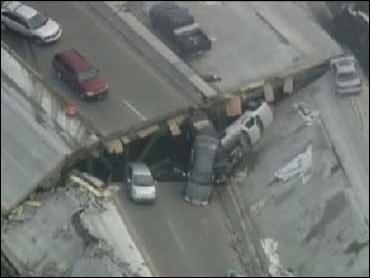 Cheryl doesn’t like driving over bridges. I could never understand that.
Cheryl doesn’t like driving over bridges. I could never understand that.
But okay. Now I can a little.
Think back a few weeks ago to the exploding steam pipe in the middle of Manhattan, and perhaps you’ll recognize that one of the big issues to face this country in the next decade or two is our aging infrastructure. Things are, quite literally, falling apart.
And let’s not forget one of the biggest infrastructure warning signs, the failure of some dams in New Orleans.
The Greensboro News & Record had an editorial on this subject just a week ago, just following several incidents of sinkholes plaguing the streets of that city:
It’s like one of those Parade Magazine brain teasers. What do these have in common? Hurricane Katrina. Flight delays nationwide. A blast of steam in New York. A traffic-stopping sinkhole on Wendover Avenue.
The answer is actually a no-brainer. Aging infrastructure. And far from being a secret, the nation’s civil engineers have been warning about it for years to little response.
Let’s face it, the decay of roads, bridges, water and sewer lines, dams and levees, the air traffic control system and electrical grid isn’t sexy. But our lives can depend on sound infrastructure and our economic health certainly does. Still, we have deferred maintenance for so many years that a huge bill is about to come due. The Wendover sinkhole was caused by broken pipes laid in 1929 and 1930. Jolson was on Broadway when Manhattan’s 83-year-old exploding steam pipe was installed. The levees that gave way in New Orleans were accidents waiting to happen. And the air traffic control system is a relic.
In 2005, the American Society of Civil Engineers reported that it would take $1.6 trillion to bring the nation’s vital structures up to snuff. Its report card for North Carolina gave the state a D for airports, dams and roads; a C for bridges, schools, drinking water, waste water and storm water; a lone B for rail. Overall, a C minus.
The looming bill for North Carolina is huge and may not fully take into account an anticipated population increase of 50 percent. It does figure on $28 billion for needed road and bridge work, $6 billion for waste water and $3 billion for drinking water.
The numbers are imposing, but the cost of neglect can be even higher. Fuel is wasted in epic quantities by inadequate roads that slow transit and commerce. Immense business losses are incurred when flights are late 30 percent of the time. And how can you put a number on a New Orleans swept away and half its population displaced?
Much of Europe had to be rebuilt after World War II, and it has continued to fund improvements. Newer economies have new infrastructure.
We are forced to play catch-up. A public infrastructure commission chaired by banker Felix Rohatyn and former Sen. Warren Rudman recommends a national investment corporation to streamline financing of improvements through government-backed bonds.
Whatever shape a fix takes, a fix is urgently needed. Every candidate for state, local or national office should be forced to say how and when he or she intends to fund the upgrades needed to keep us safe, to keep up with population growth and to keep us competitive.
You can see the ASCE report card on the nation’s infrastructure, broken down by state, here. One thing the civil engineers recommend?
Congress must enact the National Infrastructure Improvement Act to establish the National Commission on Infrastructure of the United States.
The Commission would study the present condition of the nation’s various infrastructure systems and report to Congress by 2009 on the capacity of our infrastructure to support the national economy, the age of the systems and possible methods to finance improvements.
Sounds like a reasonable first step. Now, it’s too early to tell if the tragic Minneapolis bridge collapse was due to the fact that it has been neglected (indeed, some sketchy reports indicate that there were improvements being made to the bridge at the time of the collapse — i.e., a jackhammer was working on it). But regardless, I think we’re going to see more of this type of news — bridge collapses, pipe explosions, dam breaks, etc. — in the years to come, unless we do something about it.

